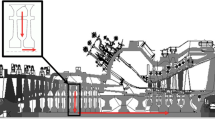Abstract
This paper presents a numerical investigation on the momentum and thermal characteristics of an intercooler connection hose that is in use in the 1.3 SDE 75 CV type FIAT engine. Computational analyses are carried out with ANSYS FLUENT v.12.0.1, where both stationary and vibrating scenarios are handled. The work is structured in accordance with the “Subsystem Functional Description for Charge Air Hoses Fiat 225 Euro 5” FIAT standard, where the air mass flow rate, temperature, and gage pressure at the hose inlet are identified as \( {\mathop m\limits^ \cdot }\) = 0.085 kg/s, T in = 90°C, and P in = 130 kPa, respectively. In the stationary case, it is determined that the pressure loss value in the air domain of the hose is ΔP K = 1.50 kPa; moreover, the corresponding data for the temperature drop is ΔT = 0.80°C. Vibration is characterized by employing simple harmonic motion at the engine side of the hose. The fluid–solid interaction methodology showed that pressure loss values grow due to vibration; moreover, the impact of vibration came out to generate diverse fluctuation schemes at different sections of the hose.
Similar content being viewed by others
References
Schroden T, Keuper D (1991) Development of a high-tech hose for a high-tech car turbo engine. Kautsch Gummi Kunstst 44:872–878
Maihle FL (1986) Safety concerns on hose and engine pressures. Fire Eng 139:16–16
Baaser H (2007) Global optimization of length and macro-micro transition of fabric-reinforced elastomers with application to a brake hose. Comput Mater Sci 39:113–116
Cooke R, House R, Lawson IJ (2001) Hand-arm vibration syndrome from exposure to high-pressure hoses. Occup Med-Oxford 51:401–409
Kain RM (2000) Case history—ambient temperature SCC of stainless steel high-pressure hose connectors. Mater Perform 39:96–98
Hau LN, Wang BJ (2007) On MHD waves, fire-hose and mirror instabilities in anisotropic plasmas. Nonlinear Process Geophys 14:557–568
Friedrichs O, Borschulte A, Zuttel A (2008) Controlled mechanically activated hydrogen sorption. Int J Hydrog Energy 33:5606–5610
Ilardo R, Williams CB (2010) Design and manufacture of a Formula SAE intake system using fused deposition modeling and fiber-reinforced composite materials. Rapid Prototyp J 16:174–179
Ilgamov MA, Ratrout RA (1999) Large deflection of superconducting cable. Int J Non-Linear Mech 34:869–880
Cronin K, Byrne E, Leary PO (2007) Prevention of thermo-hydraulic rupture of solvent transfer pipes in the pharmaceutical industry. J Loss Prev Process Ind 20:7–14
Rath C, Farjas J, Roura P (2004) Gas renewal in the horizontal furnace of a thermobalance. Thermochim ACTA 412:113–119
Cho JR, Song JI, Choi JH (2006) Prediction of effective mechanical properties of reinforced braid by 3-D finite element analysis. Fract Strength Solids 306:799–804
Simmons D (1997) High performance environments: the case for polymeric flexible hoses. Polym Polym Compos 5:563–571
Stoeckel D, Borden T (1992) Actuation and fastening with shape memory alloys in the automotive industry. Metall 46:668–672
Marquez A, Fazzini PG, Otegui JL (2009) Failure analysis of flexible metal hose at compressor discharge. Eng Fail Anal 16:1912–1921
Liu YC, Hwang YF, Huang JH (2009) Modes of wave propagation and dispersion relations in a cylindrical shell. J Vib Acoust-Trans ASME 131: article number: 041011
Drew JE, Longmore DK, Johnston DN (1997) Measurement of the longitudinal transmission characteristics of fluid-filled hoses. Proc Inst Mech Eng Part I-J Syst Control Eng 211:219–228
Nishimura S, Matsunaga T (2000) Analysis of response lag in hydraulic power steering system. JSAE Rev 21:41–46
Yu JH, Kojima E (1998) Wave propagation in fluids contained in finite-length anisotropic viscoelastic pipes. J Acoust Soc Am 104:3227–3235
Drexel MV, Ginsberg JH (2001) Modal overlap and dissipation effects of a cantilever beam with multiple attached oscillators. J Vib Acoust-Trans ASME 123:181–187
Shaw SW, Pierre C (2006) The dynamic response of tuned impact absorbers for rotating flexible structures. J Comput Nonlinear Dyn 1:13–24
Sivaprasad R, Venkatesha S, Manohar CS (2009) Identification of dynamical systems with fractional derivative damping models using inverse sensitivity analysis. CMC-Comput Mater & Contin 9:179–207
Perlov BM, Alesov MB (1996) Mathematical modeling of spatial vibrations of lengthy hose structures. Ocean Eng 23:257–269
Wang CM, Kitipornchai S, Reddy JN (2000) Relationship between vibration frequencies of Reddy and Kirchhoff polygonal plates with simply supported edges. J Vib Acoust-Trans ASME 122:77–81
Anonymous (2008) Subsystem functional description (SSFD) for charge air hoses Fiat 225 Euro 5
Anonymous (2009) ANSYS FLUENT v.12.0.1 Manual
Rhie CM, Chow WL (1982) A numerical study of the turbulent flow past an isolated airfoil with trailing edge separation. AIAA Paper 82-0988
Chung J, Hulbert GM (1993) A time integration algorithm for structural dynamics with improved numerical dissipation: the generalized-method. J Appl Mech 60:371–379
Incropera FP, DeWitt DP (2001) Fundamentals of heat and mass transfer. Wiley, New York
http://www.matsceng.ohio-state.edu/mse205/lectures/chapter20/chap20.pdf. Accessed 25 November 2009
http://www.faqs.org/patents/app/20090004416. Accessed 22 November 2009
http://www.erdemir.com.tr/images/urun_hizmetler/Katalog_2007_TR.pdf. Accessed 21 November 2009
Hocheng H, Pa PS (2003) Continuous secondary ultrasonic electropolishing of an SKD61 cylindrical part. Int J Adv Manuf Technol 21:238–242
http://www.shapa.co.uk/pdf/techdata.pdf. Accessed 17 October 2009
Author information
Authors and Affiliations
Corresponding author
Rights and permissions
About this article
Cite this article
Uysal, A., Ozalp, A.A., Korgavus, A. et al. Numerical modeling of the momentum and thermal characteristics of air flow in the intercooler connection hose. Int J Adv Manuf Technol 60, 811–824 (2012). https://doi.org/10.1007/s00170-011-3591-0
Received:
Accepted:
Published:
Issue Date:
DOI: https://doi.org/10.1007/s00170-011-3591-0




